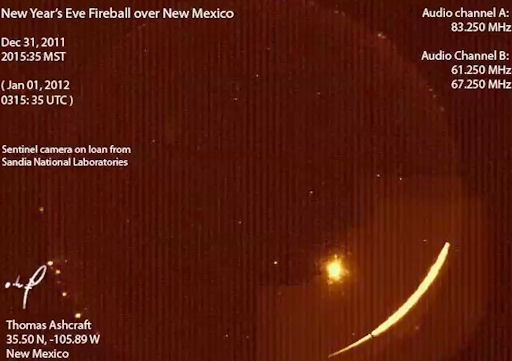NEW YEAR'S FIREBALL: The first bright fireball of the New Year streaked over the southwestern USA on Jan. 1st at 03:15 UT. It was visible from Arizona, Colorado and New Mexico. "I was able to see it out my window," reports amateur astronomer Thomas Ashcraft from his rural observatory outside of Santa Fe. "It was brilliant turquoise blue." Ashcraft operates a combination all-sky camera/forward-scatter meteor radar system, which captured the fireball's flight. Click on the image to play the movie--and don't forget to turn up the volume to hear the ghostly radar echo:
Cameras belonging to NASA's All-Sky Fireball Network also recorded the fireball from multiple locations. An orbit calculated from those data show that the fireball was a random meteoriod hailing from the asteroid belt between Mars and Jupiter. It hit Earth's atmosphere at 26 km/s (58,000 mph), which is relatively slow compared to other meteoroids, and disintegrated 82 km above Earth's surface.
"This was an auspicious start to 2012," says Ashcraft. "Clear skies and Happy New Year!"

![]()
Solar wind
speed: 351.0 km/sec
density: 5.7 protons/cm3
explanation | more data
Updated: Today at 1515 UT
![]()
X-ray Solar Flares
6-hr max: B8 1326 UT Jan01
24-hr: C3 0734 UT Jan01
explanation | more data
Updated: Today at: 1500 UT
![]()
![]()
![]()
Daily Sun: 31 Dec 11
![]()
![]()
Sunspot 1389 poses a continued threat for M-class solar flares. Credit: SDO/HMI
![]()
![]()
![]()
Sunspot number: 68
What is the sunspot number?
Updated 30 Dec 2011
Spotless Days
Current Stretch: 0 days
2011 total: 2 days (<1%)
2010 total: 51 days (14%)
2009 total: 260 days (71%)
Since 2004: 821 days
Typical Solar Min: 486 days
Updated 30 Dec 2011
The Radio Sun
10.7 cm flux: 141 sfu
explanation | more data
Updated 30 Dec 2011
![]()
![]()
![]()
Current Auroral Oval:
Switch to: Europe, USA, New Zealand, Antarctica
Credit: NOAA/POES
![]()
![]()
![]()
Planetary K-index
Now: Kp= 1 quiet
24-hr max: Kp= 1 quiet
explanation | more data
![]()
Interplanetary Mag. Field
Btotal: 5.0 nT
Bz: 1.7 nT south
explanation | more data
Updated: Today at 1527 UT
![]()
![]()
![]()
Coronal Holes: 31 Dec 11
![]()
![]()
Solar wind flowing from this coronal hole will buffet Earth's magnetic field from now until ~Jan. 2. Credit: SDO/AIA.
![]()
![]()
![]() SPACE WEATHER
SPACE WEATHER
NOAA Forecasts

![]()
![]()
Updated at: 2011 Dec 31 2200 UTC
![]()
![]()
![]()
![]()
Geomagnetic Storms:
Probabilities for significant disturbances in Earth's magnetic field are given for three activity levels: active, minor storm, severe storm
![]()
Updated at: 2011 Dec 31 2200 UTC
![]()
Mid-latitudes
![]()
High latitudes





